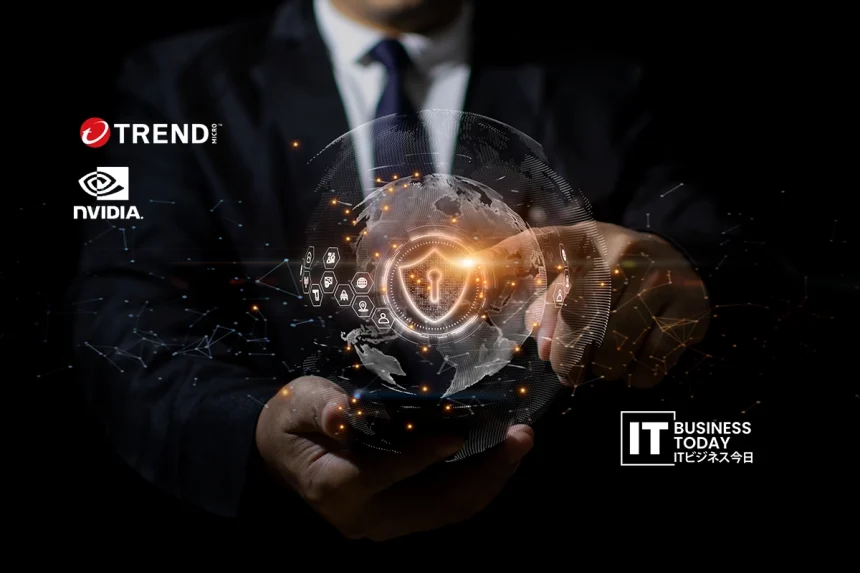The cybersecurity-themed conference “Black Hat USA 2025” is being held at the Mandalay Bay Convention Center in Las Vegas, Nevada, USA from August 2nd to August 7th. On August 5th, a co-hosted event, “The AI Summit at Black Hat USA 2025” (hereinafter referred to as “AI Summit”), was held at the same venue.
Rachel Jin, Chief Enterprise Platform Officer (CEPO) at Trend Micro, delivered a keynote speech at the AI Summit, stating, “In the age of AI, cybersecurity must be proactive. To achieve this, Trend Micro is collaborating with NVIDIA to realize cybersecurity through digital twins.” She emphasized that by combining NVIDIA’s GPU and software solutions with the company’s cybersecurity software, they will create a digital twin cybersecurity environment, shifting from traditional reactive security measures to proactive security measures.
Black Hat, the Most Prestigious Tech Conference for Cybersecurity: Black Hat USA 2025 is the flagship cybersecurity conference held globally under the “Black Hat” brand. It is usually held annually around August in Las Vegas, Nevada. The hacker event known as “DEF CON” is scheduled to begin the day after the final day of Black Hat (August 7 this year), and many attendees are said to be participating in both events. While DEF CON is well known as a hacker festival, Black Hat is a more business-oriented event, featuring a variety of presentations from companies offering cybersecurity solutions. Black Hat’s main keynote speech is scheduled for August 6, effectively splitting the event into two days. Among Black Hat’s events, the AI Summit focuses on AI cybersecurity. Ian Swanson, co-founder and CEO of Protect AI, delivered one of the keynote speeches, saying, “When I spoke about AI security at this event three years ago, only a few dozen people attended. Now, however, we’re hosting events with nearly 1,000 attendees. The level of enterprise interest in AI security has changed dramatically over the past few years.” This succinctly sums up the rapid rise in interest in AI security among many companies. Traditionally, AI has been a hot topic of discussion, focusing on what applications running on it can do, or whether AI applications are even secure. However, AI has now reached a point where it can be said to be IT itself. Attention is now being paid to the security of the AI data centers (also known as AI factories) behind the scenes where AI applications run, as well as the security of the middle layer (operating systems, middleware, and AI application development environments) that run AI applications on those data centers. Companies are concerned about “AI security” to ensure that these middle layers are secure and reliable, especially when using AI as infrastructure.
Also Read: CTC Launches Darktrace AI for Network Threat Detection
Concerns about AI security are emerging as AI evolves from AI agents to agentic AI. Jin of Trend Micro, one of the keynote speakers, stated, “AI security is often broadly defined, but it actually has two aspects. One is ‘security for AI,’ and the other is ‘security utilizing AI.'” Trend Micro’s AI security solutions are focused on both security solutions that protect the AI infrastructure itself and security solutions that utilize AI to enhance security. “Security for AI” refers to solutions that protect AI-dedicated data centers, such as those known as AI factories, comprised of GPU servers and other components, and the AI execution infrastructure that runs the middle-layer software environment on those servers from attacks by attackers and other actors. This concept is easier to understand if you think of it in terms of a client PC. A typical PC runs an OS and middleware on top of the PC hardware (SoC, memory, storage, etc.), and applications run on top of that. Until now, discussions of AI security have focused almost entirely on the application layer, with little attention paid to protecting the components below the middleware. However, as such AI factories will replace traditional data centers (composed of CPUs, GPUs, etc.) and OSs in the future, the security of AI factories is attracting significant attention. In contrast, “AI-enabled security” is the concept of using AI to improve the security of enterprise IT systems, including traditional systems, such as AI factories, clouds, on-premise data centers, and networks. Security companies are considering offering solutions in the near future in which AI learns from past attacks and autonomously configures enterprise IT systems based on that information. For example, at Zenith Live 2025 in June, Zscaler announced its intention to develop an agent-based AI (AI) that autonomously responds to AI attacks. The emergence of security solutions using AI agents that automatically process tasks and even more autonomously is expected to dramatically change the face of the security industry.
Trend Micro Adds Digital Twin Function to Trend Vision One, an AI-Enabled Security Environment. Trend Micro’s Jin explained the “Digital Twin Function,” a solution the company announced on July 31. This function creates a virtual copy of the actual environment of an enterprise IT system and then attacks that virtual environment with AI or other tools to identify vulnerabilities. Patches can be applied to the virtual environment to verify their effectiveness, allowing for verification without impacting the actual enterprise IT system. Finally, patches that have been confirmed to be effective can be applied to the actual environment, enabling more reliable and safer verification of patch operation than ever before. This type of digital twin technology is currently mainly used for creating digital twins for factories, where factories are replicated in a virtual environment and various demonstration experiments are carried out in that virtual space to discover hidden problems in the factory and improve efficiency. The digital twin for AI security unveiled by Trend Micro is slightly different from this, as it involves copying and running enterprise IT systems, whose real-world environments are also digitized, in a virtual space. Jin said, “AIFactory is a full-stack, enterprise-grade infrastructure environment for running AI applications, AI agents, and agentic AI. However, there are several risks, including the use of open source models, data leaks, inappropriate behavior during inference, difficulty in properly running highly complex agents, and compliance issues. “Digital twins are effective in addressing these security concerns,” Jin said, explaining that the digital twin functionality will be provided in the Trend Vision One Agentic AI Cybersecurity Platform (hereinafter referred to as Trend Vision One), the company’s integrated AI security solution for agentic AI. According to Jin, Trend Vision One has a three-layer structure: a data protection layer, an AI infrastructure layer, and an agentic AI layer, with features to enhance security at each layer. The digital twin functionality announced this time is planned to be integrated into the AI infrastructure layer. Trend Vision One also integrates specialized cybersecurity LLMs, which will enable expanded functionality such as data protection and digital twins. For example, the digital twin allows for simulated cybersecurity battles between the blue and red teams, and the LLM identifies security holes in the company’s network. This allows corporate IT managers to apply patching measures to the digital twin’s virtual environment, test them, and then apply them to the real environment. According to Jin, Trend Micro’s vision is that “in the future, agentic AI will be able to perform these tasks automatically.” This could mean that agentic AI could autonomously conduct mock battles and patch application trials in the digital twin, allowing humans to manage enterprise IT systems simply by issuing commands.
Collaboration with NVIDIA to Realize Digital Twin Functions, Utilizing NVIDIA AI Enterprise, NVIDIA NIM, and More During Jin’s keynote speech, Bartley Richardson, Senior Director of Engineering for Agentic AI at semiconductor manufacturer NVIDIA, appeared on stage as a guest speaker. He explained the two companies’ collaboration on Trend Vision One’s digital twin functions. According to Trend Micro, this digital twin function is realized using the company’s hybrid (on-premise and cloud) AI data center, which is comprised of NVIDIA GPUs, as well as NVIDIA AI Enterprise, an integrated development environment for implementing AI, and NVIDIA NIM microservices for inference-based AI applications. NVIDIA provides these two pieces of software as software development environments that make it easy for enterprises to develop AI inference environments. Trend Micro and NVIDIA collaborated to utilize these software to realize this digital twin function. NVIDIA’s Richardson stated, “The expansion of AI increases cybersecurity risks. By utilizing the digital twin created through our collaboration, we can proactively detect threats before they occur.” He explained that Trend Micro’s digital twin function is an effective countermeasure against the ever-expanding cybersecurity threats that continue to grow with the spread of AI. While typical digital twin functions (such as factory digital twins) typically use NVIDIA’s inference microservices and Omniverse, NVIDIA’s digital twin solution, this time Trend Micro’s digital twin did not utilize Omniverse. According to Jin, “Omniverse covers simulations of real physical environments, but this time it was a virtual IT infrastructure, so that wasn’t necessary. Instead, we prepared and deployed our own development environment to simulate enterprise IT systems.”
According to Trend Micro’s Jin, testing of these digital twin functions has already begun, with plans to make them available to customers within the year. According to a source, they are currently recruiting beta testers, particularly in the Japanese region, so enterprises interested should contact Trend Micro.Utilizing NIM and Other Technologies During Jin’s keynote speech, Bartley Richardson, Senior Director of Engineering for Agentic AI at semiconductor manufacturer NVIDIA, appeared on stage as a guest speaker and explained the collaboration between the two companies on Trend Vision One’s digital twin functionality. According to Trend Micro, this digital twin functionality is realized using the company’s hybrid (on-premise and cloud) AI data center, which is comprised of NVIDIA GPUs, as well as NVIDIA AI Enterprise, an integrated development environment for implementing AI, and NVIDIA NIM Microservices for inference-based AI applications. NVIDIA provides these two software packages as software development environments that make it easy for enterprises to develop AI inference environments. Trend Micro and NVIDIA collaborated to utilize these software to realize this functionality. NVIDIA’s Richardson stated, “The expansion of AI increases cybersecurity risks. By utilizing the digital twin we have created together, we can proactively detect threats before they occur.” He explained that Trend Micro’s digital twin functionality is an effective countermeasure against the ever-expanding cybersecurity landscape due to the widespread adoption of AI. While general digital twin functions (such as factory digital twins) typically utilize NVIDIA’s inference microservices and Omniverse, NVIDIA’s digital twin solution, Trend Micro’s digital twin did not utilize Omniverse. According to Jin, “Omniverse covers simulations of real-world physical environments, but since this was a virtual IT infrastructure, it wasn’t necessary. Instead, we prepared and deployed our own development environment for simulating enterprise IT systems.”
According to Trend Micro’s Jin, testing of these digital twin functions has already begun, with plans to make them available to customers within the year. According to a source, Trend Micro is currently recruiting beta testers, particularly in Japan, so interested enterprises should contact Trend Micro.Utilizing NIM and Other Technologies During Jin’s keynote speech, Bartley Richardson, Senior Director of Engineering for Agentic AI at semiconductor manufacturer NVIDIA, appeared on stage as a guest speaker and explained the collaboration between the two companies on Trend Vision One’s digital twin functionality. According to Trend Micro, this digital twin functionality is realized using the company’s hybrid (on-premise and cloud) AI data center, which is comprised of NVIDIA GPUs, as well as NVIDIA AI Enterprise, an integrated development environment for implementing AI, and NVIDIA NIM Microservices for inference-based AI applications. NVIDIA provides these two software packages as software development environments that make it easy for enterprises to develop AI inference environments. Trend Micro and NVIDIA collaborated to utilize these software to realize this functionality. NVIDIA’s Richardson stated, “The expansion of AI increases cybersecurity risks. By utilizing the digital twin we have created together, we can proactively detect threats before they occur.” He explained that Trend Micro’s digital twin functionality is an effective countermeasure against the ever-expanding cybersecurity landscape due to the widespread adoption of AI. While general digital twin functions (such as factory digital twins) typically utilize NVIDIA’s inference microservices and Omniverse, NVIDIA‘s digital twin solution, Trend Micro‘s digital twin did not utilize Omniverse. According to Jin, “Omniverse covers simulations of real-world physical environments, but since this was a virtual IT infrastructure, it wasn’t necessary. Instead, we prepared and deployed our own development environment for simulating enterprise IT systems.” According to Trend Micro’s Jin, testing of these digital twin functions has already begun, with plans to make them available to customers within the year. According to a source, Trend Micro is currently recruiting beta testers, particularly in Japan, so interested enterprises should contact Trend Micro.
SOURCE: Yahoo







